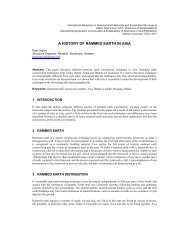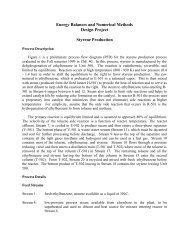Polymer Composite Retrofits Strength Concrete Structures - CEMR
Polymer Composite Retrofits Strength Concrete Structures - CEMR
Polymer Composite Retrofits Strength Concrete Structures - CEMR
Create successful ePaper yourself
Turn your PDF publications into a flip-book with our unique Google optimized e-Paper software.
Robert J. Odello<br />
Director, Waterfront <strong>Structures</strong> Division<br />
Naval Facilities Engineering Service Center<br />
Port Hueneme, CA<br />
INTRODUCTION<br />
This article describes Navy efforts to apply composite materials<br />
to pier decking and support columns for the purpose of repairing<br />
deteriorating installations and strengthening structures not<br />
designed for current load requirements. The successes of this<br />
program have laid the groundwork for a better understanding<br />
of how composite retrofits work in real-world, reinforced concrete<br />
structures serving in harsh environments. These retrofits<br />
have many similarities to some of the solutions proposed to<br />
retrofit buildings to make them more blast resistant. The<br />
approaches, if implemented, will increase load carrying capacity<br />
of floor sections, can enable sections designed only for<br />
gravity loading to withstand negative (upward) loads, and will<br />
reinforce support columns for higher strength and greater<br />
resistance to progressive collapse. Lessons learned in these Navy<br />
projects will help further advance the protection and hardening<br />
of land-based structures.<br />
BACKGROUND<br />
The Navy has many waterfront facilities that are already old<br />
and continuing to degrade as they remain in use. Many of these<br />
facilities are mission critical piers and wharfs that were built<br />
during or soon after World War II. The replacement rate for<br />
these structures has been slow, with the average age continuing<br />
to increase. The cost of current deficiencies is approaching $1B<br />
for piers and wharfs.<br />
The two primary reasons for these structural deficiencies are<br />
deterioration and mission changes. In some installations saltwater<br />
has migrated through cracks or permeated the concrete<br />
to initiate corrosion of the steel reinforcing bars. As the reinforcing<br />
bars corrode, they expand and cause cracking of the<br />
concrete, thus leading to more saltwater intrusion. There is also<br />
speculation that global warming is leading to higher tide levels<br />
and raising the level of the splash zone to further aggravate the<br />
problem. In more recent structures, there is also evidence of<br />
chemically-induced deterioration of the concrete due to curing<br />
processes or aggregate composition. Changes in mission and<br />
operating practices also lead to deficiencies in structural<br />
capacity of piers.<br />
In the past, the Navy designed and built piers with railmounted<br />
cranes which typically had large beams under the rails<br />
to take the loads. Today, the Navy prefers truck-mounted<br />
mobile cranes. These allow more flexibility in operations, since<br />
they can set-up anywhere on the deck. However, not all areas of<br />
the decks are able to sustain the outrigger loads from such<br />
cranes. These loads are increasing, because more ship maintenance<br />
and repair operations are being conducted pier-side<br />
rather than in shipyards.<br />
Conventional methods to reduce deficiencies are costly and<br />
disruptive to operations. Construction of new piers requires<br />
budget approval and subsequent funding. Approvals may take<br />
many years, and actual construction can prevent operations at<br />
the site of the project and at adjacent berths. Conventional<br />
repair practices tend toward brute force methods. A typical<br />
approach is to simply increase the thickness of the deck.<br />
However, the increased mass could lead to seismic problems.<br />
Further, if the corrosion products are not carefully removed and<br />
the areas sealed, the corrosion will continue. This situation has<br />
led to the search for new materials or technologies that the<br />
Navy could use to strengthen and repair these structures.<br />
TECHNOLOGY DEVELOPMENT<br />
The Naval Facilities Engineering Service Center (NFESC),<br />
under sponsorship by the Office of Naval Research began a<br />
project in the early 1990’s to explore the use of composite<br />
materials for repairing or strengthening waterfront structures.<br />
During that time the Navy teamed with the Army Corps of<br />
Engineers and what is now known as the Market Development<br />
Alliance (MDA) of the FRP (Fiber Re i n f o rced Po l y m e r )<br />
<strong>Composite</strong>s In d u s t ry on a project for the Constru c t i o n<br />
Productivity Advancement Research (CPAR) Program. The<br />
program involved testing of fender piles fabricated from FRP<br />
materials. The Navy uses fender piles* along the edges of piers<br />
to protect ships from impacts with the pier or wharf structure.<br />
Some of the piles were completely FRP, while others used an<br />
FRP casing around a concrete core [1][2]. This second type<br />
showed very good stiffness and strength properties under bending<br />
loads. The analogy to column wrapping for seismic<br />
upgrades was obvious.<br />
NFESC fabricated a test site in Port Hueneme, CA to evaluate<br />
other FRP technologies in a controlled waterfront environment<br />
(Figure 1). The Army Corps of Engineers CPAR Program<br />
contributed funding and member companies of the<br />
<strong>Composite</strong>s Institute of the Society of the Plastics Industry<br />
The AMPTIAC Quarterly, Volume 6, Number 4 25

















